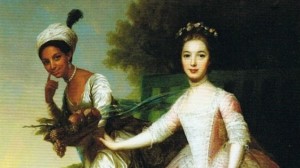Belle: The Real Story
Posted on May 8, 2014 at 8:00 am
 “Belle,” expanding to theaters across the country tomorrow, is based on the real-life 18th century story of Dido Elizabeth Belle, the illegitimate daughter of a titled British Naval officer (played in the film by Matthew Goode of “A Good Wife”) and a slave from the West Indies. Her father brings her to live with his uncle, the British equivalent of the Chief Justice of the Supreme Court. In the film, directed by a British woman of African heritage, Amma Asante, the themes of gender, money, class, and race are explored with sensitivity and insight reflecting some of what we have learned in the nearly 400 years since Belle appeared in a famous portrait with her cousin.
“Belle,” expanding to theaters across the country tomorrow, is based on the real-life 18th century story of Dido Elizabeth Belle, the illegitimate daughter of a titled British Naval officer (played in the film by Matthew Goode of “A Good Wife”) and a slave from the West Indies. Her father brings her to live with his uncle, the British equivalent of the Chief Justice of the Supreme Court. In the film, directed by a British woman of African heritage, Amma Asante, the themes of gender, money, class, and race are explored with sensitivity and insight reflecting some of what we have learned in the nearly 400 years since Belle appeared in a famous portrait with her cousin.
There was a real Belle, and as in the film she was known to her family as Dido, born around 1761. She lived with her great-uncle, the Earl of Mansfield. He and his wife and unmarried sister raised her with her cousin, Lady Elizabeth Murray. The girls were around the same age, as shown in the portrait, and raised as sisters. Dido was, as shown in the movie, loved by her family but was subjected to restrictions based not just on her race but on her illegitimacy. A contemporary report from a visitor to the home suggested that she was more of a companion to her cousin than an equal. She had some responsibilities over housekeeping, but so did her unmarried aunt. A fascinating historical account noted that she served as a kind of secretary to her great-uncle, which suggests that she had a level of respect for her intellectual ability that was unusual for people of her race and gender at the time.
The move toward abolition of slavery in Great Britain is as gripping and complex a story as the movement in the United States. There were two big differences. First, since slavery was offshore and unseen by most citizens, it was more difficult to make its fundamental immorality clear to the population. Once it was made clear, it led to the first ever populist political movement. This story is very well told in the film “Amazing Grace.” Second, the abolition of slavery was accomplished in 1833, decades earlier than in the United States, and without armed conflict.
One reason for that was a crucial decision made by the courts in England in 1772, a decision by none other than Belle’s great-uncle, Lord Mansfield. While the facts of that case are very different from those described in the film, the decision was the first acknowledgement by the court of the inherent offensiveness of slavery and was an important precedent for framing the arguments over slavery that followed. We will never know whether Belle influenced her great-uncle explicitly or by the example of her intelligence and character, as the movie has it. But it is fair to wonder whether he would have ruled differently had he not had the unquestioned affection for Belle that has been documented.
For more about Belle, read this scholarly article by Henry Louis Gates and Belle: The Slave Daughter and the Lord Chief Justice.
